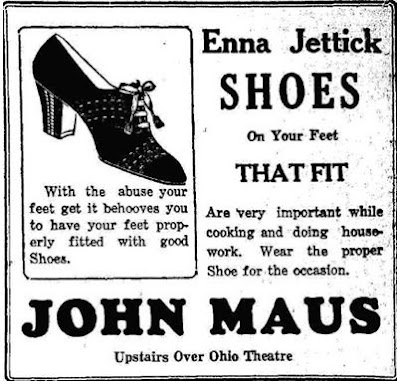After working as a salesman for W.O. Stubig’s shoe store, John N. Maus opened his own business on Market Street in Sandusky. The advertisement above, from the Sandusky Star Journal of July 6, 1916, stated that the store's temporary quarters were above the Manhattan store. The German surname Maus translates to “mouse” in English, so a mouse was often seen in ads for Maus Shoes. By January, 1917, John Maus moved his shoe store to the upper level of the Schade Theatre building.
In May of 1920, the movie, A Regular Girl was playing at the Schade Theatre on West Market Street in Sandusky.
You can see signs for the Maus shoe store on the second floor of the building. The shoe store was next to the office of Dr. McCormick, the eye doctor.
In this 1935 advertisement, John Maus declared that he sold shoes that fit well, so that ladies could have proper shoes “for cooking and doing housework.” By this time the theater on West Market had become the Ohio Theatre.
A notice in the November 18, 1968 issue of the Sandusky Register informed customers that Maus Shoes had moved from Market Street to 145 Columbus Avenue. This “back to school” ad appeared in the August 26, 1969 issue of the Register.
After the death of John N. Maus in 1977, his son Glenn Maus took over the business. After over sixty years of doing business in Sandusky, Maus Shoes had a large going out of business sale in May of 1984. Your parents or grandparents probably purchased shoes at this popular local shoe store!
A shoe horn from Maus Shoes is now in the collections of the Follett House Museum.

 this blog
this blog
































.jpg)













